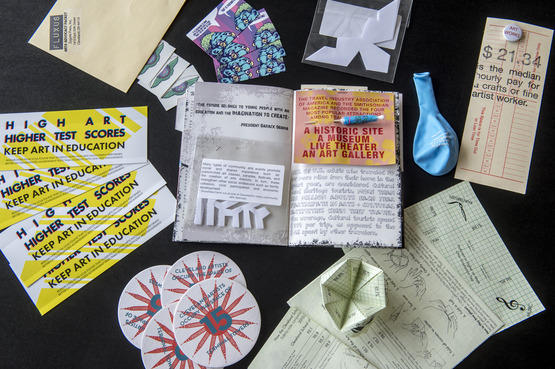
News . Feature Stories . CIA students add creativity to art awareness project
News
April 30, 2014
CIA students add creativity to art awareness project
Fluxus teaches students they have a role as arts advocates

By Cindi Deutschman-Ruiz
A surprise gift is arriving in the mailboxes of thought leaders throughout Ohio. Engaging, visually arresting, tactile, and full of perspective-changing information, the gift is designed to make its recipients understand better the pivotal place the arts hold in our community. Helping to design this gift taught a group of Cleveland Institute of Art students some valuable lessons.
The Fluxus Arts Advocacy Project is a packet of printed and interactive materials, gathered for the enjoyment and edification of those who have the power to affect regional arts funding. It is the brainchild of Zygote Press Managing Director Liz Maugans, and a collaborative production of Zygote, its interns, CIA students, and other Northeast Ohio artists.
A wide variety of materials have been incorporated into the packet.
A bumper sticker showcases the connection between arts education and higher student test scores. Magnets reveal that the arts are a major draw for people who travel--occupying two spots among the top four most popular activities. A coaster describes the sheer number of area artists by noting that, if brought together in one location, they would actually require the floor space of 15 Terminal Towers. A folded-paper “fortune teller” compares student achievement at the Cleveland School of the Arts with state averages.
The “ah-ha” moment that gave rise to this project took place at the national Alliance for Artists Communities Conference, which Maugans attended. Keynote speaker Wayne Lawson, former executive director of the Ohio Arts Council, asked participants to raise their hands if they could identify their own elected officials. According to Maugans, you could count on one hand the number who could do so, in a crowd of about 200 people.
The experience inspired Maugans to come up with a creative way for printmaking to bring arts research to life and disseminate it into the world.
The impetus behind this Fluxus project reflects the sensibility of the original Fluxus movement, which began in the 1960s. Visionary artists of the time sought, as Maugans puts it, to “get art to the streets,” and “stir the pot a bit.”
Of course, before you can stir the pot, you have to assemble the ingredients. Here’s how that process unfolded:
Zygote interns turned to the National Endowment for the Arts, Ohio Citizens for the Arts, the Ohio Arts Council, and Community Partnership for Arts + Culture for facts and statistics about the arts, addressing their value and impact.
Maugans, along with Zygote colleague and Fluxus Art Director + Project Manager Jen Craun (both of whom are long-time adjunct faculty members at CIA), met with students of CIA Associate Professor Maggie Denk-Leigh’s Propaganda class to discuss the project.
Now, the term propaganda carries decidedly negative connotations, but Denk-Leigh points out that, at its core, propaganda involves the development of “projects and components that support ideas, movements, and awareness.” CIA’s Propaganda class allows art students to practice utilizing their artistic skills to communicate ideas in persuasive ways.
Following the initial meeting between CIA students and the folks from Zygote, the project developed along separate but intersecting lines.
At CIA, students separated into groups, brainstorming ideas for how best to showcase the facts that most captured their interest. Critiques followed, and ideas that were given the green light were then fully developed, resulting in designs for the bumper stickers, coasters, and magnets described above, among other things.
According to Denk-Leigh, providing key content for the project gave students the opportunity to learn “how to speak for themselves and for their field, in a positive and constructive way.”
Once students designed their own particular pieces, the designs were transformed into physical shape by Zygote. Project manager Jen Craun says students “seemed to drop their jaws to see their designs take physical shape.”
And, while CIA students were developing their materials, Zygote interns, along with area artists, were developing designs of their own as well.
Zygote was responsible for the final printing and organizing of all materials in the 500, numbered, limited-edition packets, and for getting those packets out to the identified movers and shakers. A feedback postcard is included in the packet, encouraging recipients share their thoughts about the project and its message.
Fluxus is remarkable in its scope, ambition and execution, but it’s also notable for something else: While the end product itself is intended to help area leaders recognize the centrality of art to our lives—and thereby understand better why substantial and reliable financial support for the arts is critical—the process of developing the project also opened its designers’ eyes to their own power as artists to shape the future.
“Fluxus, a loose international group of artists, poets, and musicians whose only shared impulse was to integrate life into art through the use of found events, sounds, and materials, thereby bringing about social and economic change in the art world.”—Encyclopedia Britannica
Above: A sampling of components of the Fluxus packets.
Latest Headlines view all
-
April 02, 2024
Cleveland Institute of Art students partner with Progressive Art Collection to exhibit Ready, Set, Relay! -
March 04, 2024
Cleveland Institute of Art announces Curlee Raven Holton Inclusion Scholar Program -
November 06, 2023
Collision of art and artificial intelligence creates murky waters for artists, curators and educators
Questions?
For more information about this or other CIA news, contact us here.
Social Feed